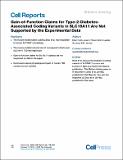Gain-of-Function Claims for Type-2-Diabetes-Associated Coding Variants in SLC16A11 Are Not Supported by the Experimental Data
Author(s)
Lander, Eric S.
DownloadPublished version (852.7Kb)
Terms of use
Metadata
Show full item recordAbstract
Human genetic variants inSLC16A11are associatedwith increased risk of type 2 diabetes (T2D). We pre-viously identified two distinct mechanisms throughwhich co-inherited T2D-risk coding and non-codingvariants disruptSLC16A11expression and activity,thus implicating reduced SLC16A11 function as thedisease-relevant direction of effect. In a recent pub-lication,Zhao et al. (2019a)argue that humanSLC16A11 coding variants confer gain of function,basing their conclusions on phenotypic changesobserved following overexpression of mutant murineSlc16a11. However, data necessary to demonstrategain-of-function activity are not reported. Further-more, several fundamental flaws in their experi-mental system—including inaccurate modeling ofthe human variant haplotype and expression condi-tions that are not physiologically relevant—preventconclusions about T2D-risk variant effects on humanphysiology. This Matters Arising paper is in response toZhao et al. (2019a), published inCell Reports. Seealso the response byZhao et al. (2019b)in this issueofCell Reports.
Date issued
2019-10Department
Massachusetts Institute of Technology. Department of BiologyJournal
Cell reports
Publisher
Elsevier BV
Citation
Hoch, Eitan et al. “Gain-of-Function Claims for Type-2-Diabetes-Associated Coding Variants in SLC16A11 Are Not Supported by the Experimental Data.” Cell reports 29 (2019): 778-780 © 2019 The Author(s)
Version: Final published version
ISSN
2211-1247